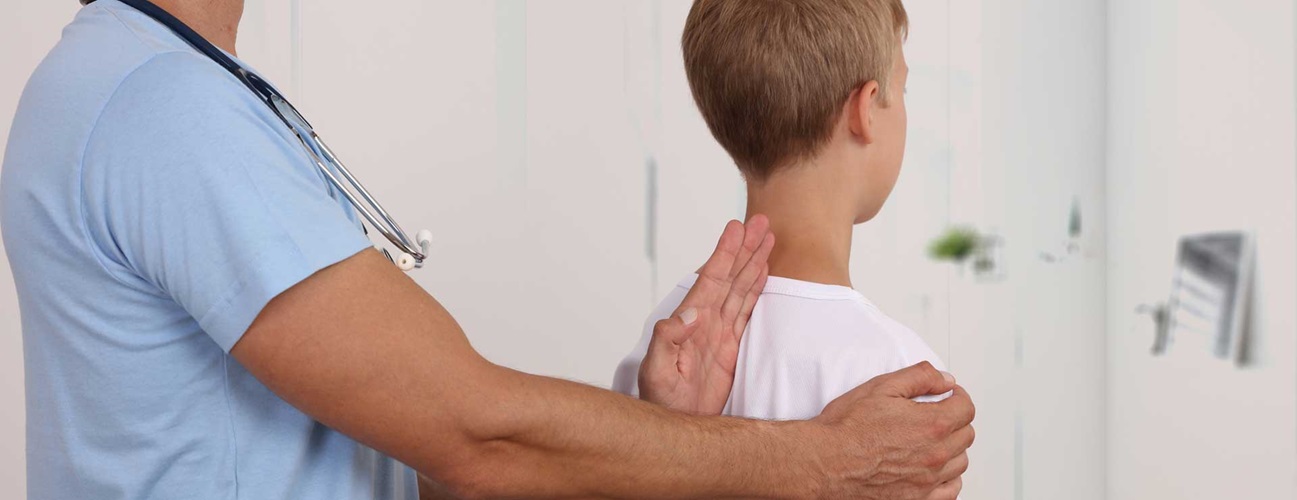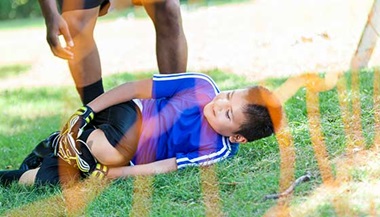Minimally Invasive Scoliosis Surgery for Children
What is minimally invasive scoliosis surgery for children?
Minimally invasive scoliosis surgery is a type of procedure done to fix an abnormal curve of the spine known as scoliosis. This type of surgery uses smaller incisions than open surgery.
The spine has some normal curves forward and backward. But it should not curve to the side. With scoliosis, the spine curves to the side in an S-shape or a C-shape. If the curve is severe, it can cause uneven shoulders or a body that appears to tilt to one side.
Minimally invasive scoliosis surgery helps to correct an abnormal curve. During the surgery, the surgeon makes several small incisions along the back. They then insert a device called a tubular retractor. This lets the surgeon reach the spine with small tools. Rods and screws are attached to the spine to help make it straighter. A special microscope and real-time X-ray images of the spine are used to help with surgery. Surgery will usually be done with general anesthesia. This makes your child sleep during the procedure. In some cases, only the area of the spine will be numbed, and your child will be awake. Your child will be given a medicine to relax them.
Minimally invasive scoliosis surgery is a fairly new method. It's not available at all hospitals or other facilities that do surgery.
Pediatric Scoliosis | Nicholas’ Story
Nicholas was diagnosed with scoliosis at age 3, and by 14, despite bracing, his curve had worsened and required surgery. He and his parents planned the procedure at Johns Hopkins with pediatric orthopaedic surgeon Paul Sponseller, but then the pandemic struck. The family knew that a delay in treatment may allow scoliosis to progress, so they were back as soon as surgeries resumed at Johns Hopkins, reassured by the care team about safety protocols. Several weeks later, Nicholas was home, healthy and practicing his golf swing.
Why might my child need minimally invasive scoliosis surgery?
Your child might need surgery if their spine has a severe curve. This is a curve of at least 40 degrees. Or your child may need surgery in the future if other treatments, such as bracing, don’t keep the curve from getting worse. Children who have only mild curves are not likely to need surgery. Your child’s healthcare provider will keep track of your child’s spine as they grow.
Surgery is the only treatment that can make the spine straight. It can correct posture and reduce or relieve pain.
If you are thinking about scoliosis surgery for your child, ask the healthcare provider if a minimally invasive method might make sense for your child. Minimally invasive scoliosis surgery can cause less harm to back muscles and other nearby tissues. It also uses smaller incisions. This can lead to less pain and a shorter recovery after surgery.
Your child might not be able to have minimally invasive scoliosis surgery if their curve is very severe.
What are the risks of minimally invasive scoliosis surgery for a child?
Every surgery has risks. Risks for minimally invasive spine surgery include:
-
Infection
-
Excess bleeding
-
Pain at the graft site
-
Nerve damage
-
Blood clots
-
Not enough bone formation. This can keep the bone from healing fully.
-
Need to be converted to an open surgery.
-
Need for a repeat surgery
Your child's risks may differ depending on their age, general health, shape of the curve, and the surgery method. Having the surgery at a facility that is experienced in the method can help lower your child's risks. Talk with your child's healthcare provider about the risks that most apply to your child.
How can I get my child ready for minimally invasive scoliosis surgery?
Talk with your child's healthcare provider about how to prepare your child for surgery. Tell the healthcare provider about all the medicines your child takes. This includes over-the-counter medicines such as aspirin. Your child may need to stop taking some medicines ahead of time.
Before the surgery, your child may need imaging tests. These may include X-rays or MRI.
Have your child follow any instructions on not eating or drinking before surgery. Tell your child's healthcare provider about any recent changes in your child’s health, such as a fever. Follow any other instructions the healthcare provider gives you before the surgery.
What happens during minimally invasive scoliosis surgery for a child?
The procedure is done by an orthopedic surgeon or neurosurgeon. They can help explain the details of your child's surgery. A typical surgery may go like this:
-
Your child may be given general anesthesia. This is to stop pain and cause your child to sleep during the surgery.
-
In some cases, your child might have a type of anesthesia that numbs only part of their body. Your child will get a medicine so that they will be very relaxed but awake during the surgery. Your child may be given antibiotics before and after the procedure to help prevent infection.
-
A healthcare provider will carefully watch your child's vital signs, like heart rate and blood pressure.
-
During the procedure, your child's surgeon will use a special type of continuous X-ray to view your child’s spine.
-
The surgeon will make several small incisions on your child's back.
-
Your child's surgeon will insert a tubular retractor into this incision. This will expose the area of the spine with the problem.
-
The surgeon will pass special small tools through this retractor, including a tiny camera and a light.
-
The surgeon will partially straighten the spine. This is done using screws, rods, and wires.
-
In some cases, the surgeon might use a bone graft to complete the repair. Bone is used from your child’s hip or from a donor.
-
The tools and tube will be removed.
-
Your child's incisions will be closed. A small bandage will be put on the wound.
What happens after minimally invasive scoliosis surgery for a child?
Your child will probably need to stay in the hospital for a few days or so after the surgery. Your child will likely have pain after the surgery. This is treated with pain medicine. Talk with your child’s surgeon about any over-the-counter pain medicines you can give your child. In most cases, the pain goes away fairly quickly. Your child can eat a normal diet as soon as they are able.
Some fluid may leak from your child’s incision. This is normal. Tell the surgeon right away if there is a lot of fluid, or if your child has a lot of pain, chills, or a fever. Call 911 if your child has severe symptoms such as trouble breathing, chest pain, numbness, weakness, or severe headache.
The surgeon will give you instructions about how your child can use their back right after the surgery. Your child might need to limit movement that involves a lot of lifting or bending.
The surgeon can let you know how long to expect your child’s recovery will be. Your child may be able to return to school in a week or two. It may take several months before your child can resume all of their normal activities. Over time, your child should be able to return to most activities. Check with your child’s healthcare provider first.
Follow all of the surgeon's instructions about your child’s treatment and follow-up appointments. Your child will likely still have a slight curve in their spine after the surgery, but this should no longer be very noticeable. The surgeon will closely monitor your child to make sure the surgery was successful.
Next steps
Before you agree to the test or the procedure, make sure you know:
-
The name of the test or procedure
-
The reason you are having the test or procedure
-
What results to expect and what they mean
-
The risks and benefits of the test or procedure
-
What the possible side effects or complications are
-
When and where you are to have the test or procedure
-
Who will do the test or procedure and what that person’s qualifications are
-
What would happen if you did not have the test or procedure
-
Any alternative tests or procedures to think about
-
When and how you will get the results
-
Who to call after the test or procedure if you have questions or problems
-
How much you will have to pay for the test or procedure







